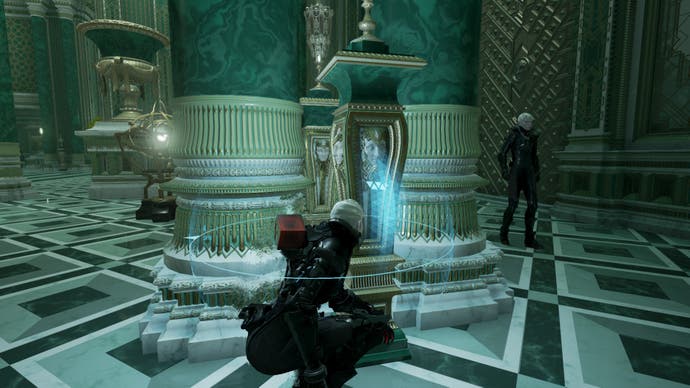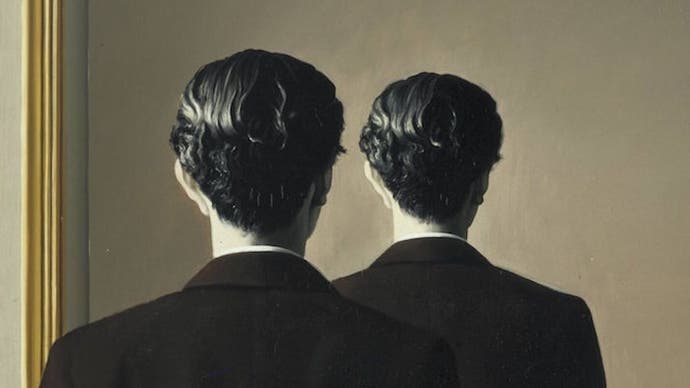What games can learn from surrealism
Play and disrupt.
One of the standout pieces at the V&A's video game exhibition Design, Play, Disrupt isn't a game or even an interesting design document. It's Le Blanc Seing, a painting by Belgian surrealist Rene Magritte, on loan from the National Gallery of Art in Washington. The painting made its way to London to acknowledge a reference in Kentucky Road Zero, the adventure game released by Cardboard Computer in 2013.
As magnificent as it can be to see the real version of a painting you've only seen by proxy, I'm not the biggest fan of its inclusion in the exhibition. Maybe it's due to my own insecurities surfacing whenever I tell the casually interested about the cultural importance of gaming, but referencing art so clearly both in a game and an exhibition can be construed as games still looking for validation in the art space. "This makes it official," reviews of exhibitions of this kind triumphantly proclaim, "Games are art after all!" The notion that game designers are people who sometimes watch films, read books or enjoy paintings seems to come as a surprise, something that isn't understood unless it's explicitly stated.
This reputation is of course one that the gaming industry often perpetuates. Certain games have influenced so many other games that their titles now serve as shorthand for game mechanics and sometimes whole genres - take Metroid, Zelda or Dark Souls. Game design stagnates when it's influenced by its own microcosm, and you can argue that games are the most fun when they take their cues from surrealism, and not just in a visual way.

Surrealist art feels mind-bending because it runs counter to what we expect. Magritte paints a town in the dark hues of the night sky while the sky above is bright blue and hung with fluffy white clouds. The edges of a scenic vista crinkle and fold over to remind you that you're not looking at the sky, you're looking at the painting of one. 'This is not a pipe', admonishes his famous painting, it's merely the image of one. Unlike other artists, Magritte's paintings look so fascinating because they are absolutely realistic. He renders the most beautifully detailed eagle, just to put it in a coat. He doesn't have to distort objects to the point of being barely recognisable, melting clocks and the like, to make you feel that something is out of order. Often all he needs to do is to use objects in an unexpected context.
Magritte opened up the world of surrealist art as something you could marvel at without having read Freud's collected works. He put faces into the sky. He would put himself in a bowler hat in his paintings because he liked himself in a bowler hat, and he put nods to his favourite type of crime fiction in his work without anything so on the nose as a direct reference.
The surreal has an established place in certain gaming genres. Take horror - once you've come face to face with a giant alligator or a humanoid wearing a pyramid on its head you come to expect the unexpected and know that things that look normal might not be normal at all. The juxtaposition between the normal and distorted is where a lot of excitement originates from. Cartoonish depictions of reality present you with a world in which anything is possible. I like to think of the Band Land Stage in the original Rayman, which has trees built of flutes and in which maracas can both be platforms and rockets. Marockets. In a world where nothing about the hero you control is realistic, the landscapes wouldn't be, either. Taxis fly in Super Mario Odyssey, and to be perfectly honest, why wouldn't they if Mario can turn into all manner of creatures himself?

Expressing surrealism mechanically can be tricky, since most games try to be intuitive and give players all the tools to independently figure out what to do. Perhaps this is why many games mainly express the surreal visually: games by Keita Takahashi and Tim Schafer let their worlds speak for themselves while the mechanics stay comparatively simple.
There are titles that go a step further, however: several games have attempted to unravel the tricky notion of the self, which is prevalent is surrealism due to its connection to psychology. Both The Swapper and Echo are games in which you can exist in the same room as yourself. Monument Valley is a visual homage to M.C. Escher that also makes use of perspective in its puzzles to show you something beyond what you're seeing at first glance, just the way a surrealist would. In Gravity Rush, you literally stand on your head more than once to find your way around.
Yet I wonder why it's so hard for games to go completely off the rails. Realistic horse manes are all well and good, but I would like more games where the world shifts on its axis and folds over like Paris in Inception. I want games to give me a goal and the tools to do the complete opposite, not to cause carnage, but to push what's possible - to play and disrupt. I want character creators to test the limits of the human body and how it should work. In a game that otherwise treats itself with complete and utter seriousness, I want to be able to walk on the ceiling and use celery sticks as weapons.
SWERY's The Missing is admirable for making a paradox of gaming instincts - usually, your limbs are best attached safely to your body, but here you take your protagonist apart bit by bit. More importantly, this is done to explore self-harm not just as a surrealist shock tactic, but also as exploration of its very relatable real-life causes.
Behind my cry for more of the unexpected lies a certain fatigue with artful games, clogged with metaphors. I find a visually interesting game just as attractive as anyone, but they are turning into genre not unlike the metroidvania or soulslike. They are calm and relaxing and evoke emotion rather than plainly expressing it. Sometimes I don't want the mountain as metaphor for emotional obstacles, I simply want characters to say the words, "I don't feel good." That is a kind of realism that games, especially triple-A ones, could put on display more often, completely without couching it in a fantastical setting, however epic.
Maybe once that is done, game designers can adopt Rene Magritte's mindset and do something just because.









